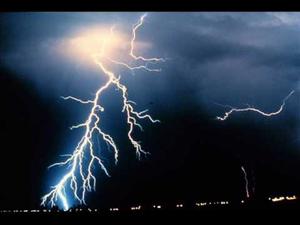DisastersChanging climate to lead to fewer, but more violent, thunderstorms
Researcher predict that for every one degree Celsius of warming, there will be approximately a 10 percent increase in lightning activity; this could have negative consequences in the form of flash floods, wild fires, or damage to power lines and other infrastructure

Future will see fewer but more violent thunderstorms // Source: sonhbr.com
Researchers are working to identify exactly how a changing climate will impact specific elements of weather, such as clouds, rainfall, and lightning. A Tel Aviv University researcher has predicted that for every one degree Celsius of warming, there will be approximately a 10 percent increase in lightning activity.
This could have negative consequences in the form of flash floods, wild fires, or damage to power lines and other infrastructure, says Professor Colin Price, head of the Department of Geophysics, Atmospheric and Planetary Sciences at Tel Aviv University. In an ongoing project to determine the impact of climate change on the world’s lightning and thunderstorm patterns, he and his colleagues have run computer climate models and studied real-life examples of climate change, such as the El Nino cycle in Indonesia and Southeast Asia, to determine how changing weather conditions impact storms.
An American Friends of Tel Aviv University release reports that an increase in lightning activity will have particular impact in areas that become warmer and drier as global warming progresses, including the Mediterranean and the Southern United States, according to the 2007 United Nations report on climate change. This research has been reported in the Journal of Geophysical Research and Atmospheric Research, and has been presented at the International Conference on Lightning Protection.
From the computer screen to the real world
When running their state-of-the-art computer models, Price and his fellow researchers assess climate conditions in a variety of real environments. First, the models are run with current atmospheric conditions to see how accurately they are able to depict the frequency and severity of thunderstorms and lightning in today’s environment. Then, the researchers input changes to the model atmosphere, including the amount of carbon dioxide in the atmosphere (a major cause of global warming) to see how storms are impacted.
The release notes that to test the lightning activity findings, Price compared their results with vastly differing real-world climates, such as dry Africa and the wet Amazon, and regions where climate change occurs naturally, such as Indonesia and Southeast Asia, where El Nino causes the air to become warmer and drier. The El Nino phenomenon is an optimal tool for measuring the impact of climate change on storms because the climate oscillates radically between years, while everything else in the environment remains constant.
“During El Nino years, which occur in the Pacific Ocean or Basin, Southeast Asia gets warmer and drier. There are fewer thunderstorms, but we found fifty percent more lightning activity,” says Price. Typically, he says,we would expect drier conditions to produce less lightning.
Researchers also found, however, that while there were fewer thunderstorms, the ones that did occur were more intense.
Fire and flood warning
An increase in lightning and intense thunderstorms can have severe implications for the environment, says Price. More frequent and intense wildfires could result in parts of the United States, such as the Rockies, in which many fires are started by lightning. A drier environment could also lead fires to spread more widely and quickly, making them more devastating than ever before. These fires would also release far more smoke into the air than before.
Researchers predict fewer but more intense rainstorms in other regions, a change that could result in flash-flooding, says Price. In Italy and Spain, heavier storms are already causing increased run-off to rivers and the sea, and a lack of water being retained in groundwater and lakes. The same is true in the Middle East, where small periods of intense rain are threatening already scarce water resources.
